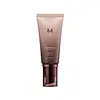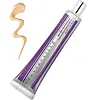What's inside
What's inside
 Key Ingredients
Key Ingredients

 Benefits
Benefits

 Concerns
Concerns

 Ingredients Side-by-side
Ingredients Side-by-side

Water
Skin ConditioningCI 77891
Cosmetic ColorantCyclopentasiloxane
EmollientDipropylene Glycol
HumectantPanax Ginseng Root Extract
EmollientPhenyl Trimethicone
Skin ConditioningButyloctyl Salicylate
Skin ConditioningCetyl PEG/PPG-10/1 Dimethicone
EmulsifyingButylene Glycol
HumectantCyclohexasiloxane
EmollientNiacinamide
SmoothingTalc
AbrasiveCalcium Stearate
Cosmetic ColorantMagnesium Sulfate
Sorbitan Sesquioleate
EmulsifyingCI 77492
Cosmetic ColorantTocopheryl Acetate
AntioxidantDimethicone
EmollientSynthetic Beeswax
Emulsion StabilisingAluminum Hydroxide
EmollientHydrogenated Polyisobutene
EmollientStearic Acid
CleansingPhenoxyethanol
PreservativeCaprylyl Glycol
EmollientCI 77491
Cosmetic ColorantGlycerin
HumectantTriethoxycaprylylsilane
Disteardimonium Hectorite
StabilisingCI 77499
Cosmetic ColorantSilica
AbrasiveAlcohol
Antimicrobial1,2-Hexanediol
Skin ConditioningDisodium EDTA
Triethyl Citrate
MaskingHydroxyethylcellulose
Emulsion StabilisingAdenosine
Skin ConditioningParfum
MaskingDimethicone Crosspolymer
Emulsion StabilisingEthylhexylglycerin
Skin ConditioningBeeswax
Emulsion StabilisingDimethicone/Vinyl Dimethicone Crosspolymer
Skin ConditioningCellulose
AbsorbentSodium Hyaluronate
HumectantPolymethylsilsesquioxane
CI 77480
Cosmetic ColorantBifida Ferment Lysate
Skin ConditioningCentella Asiatica Extract
CleansingLactose
HumectantSilica Silylate
EmollientPanthenol
Skin ConditioningDisodium Stearoyl Glutamate
CleansingDisodium Phosphate
BufferingPolysorbate 60
EmulsifyingMadecassoside
AntioxidantSodium Phosphate
BufferingButylphenyl Methylpropional
PerfumingBenzyl Benzoate
AntimicrobialWater, CI 77891, Cyclopentasiloxane, Dipropylene Glycol, Panax Ginseng Root Extract, Phenyl Trimethicone, Butyloctyl Salicylate, Cetyl PEG/PPG-10/1 Dimethicone, Butylene Glycol, Cyclohexasiloxane, Niacinamide, Talc, Calcium Stearate, Magnesium Sulfate, Sorbitan Sesquioleate, CI 77492, Tocopheryl Acetate, Dimethicone, Synthetic Beeswax, Aluminum Hydroxide, Hydrogenated Polyisobutene, Stearic Acid, Phenoxyethanol, Caprylyl Glycol, CI 77491, Glycerin, Triethoxycaprylylsilane, Disteardimonium Hectorite, CI 77499, Silica, Alcohol, 1,2-Hexanediol, Disodium EDTA, Triethyl Citrate, Hydroxyethylcellulose, Adenosine, Parfum, Dimethicone Crosspolymer, Ethylhexylglycerin, Beeswax, Dimethicone/Vinyl Dimethicone Crosspolymer, Cellulose, Sodium Hyaluronate, Polymethylsilsesquioxane, CI 77480, Bifida Ferment Lysate, Centella Asiatica Extract, Lactose, Silica Silylate, Panthenol, Disodium Stearoyl Glutamate, Disodium Phosphate, Polysorbate 60, Madecassoside, Sodium Phosphate, Butylphenyl Methylpropional, Benzyl Benzoate
Water
Skin ConditioningCyclopentasiloxane
EmollientButylene Glycol
HumectantNeopentyl Glycol Diethylhexanoate
EmollientTalc
AbrasiveGlycerin
HumectantPEG-10 Dimethicone
Skin ConditioningDimethicone
EmollientPhenyl Trimethicone
Skin ConditioningPentylene Glycol
Skin ConditioningPEG-150
HumectantMagnesium Sulfate
Aluminum Hydroxide
EmollientStearic Acid
CleansingSilica Dimethyl Silylate
EmollientDimethicone/Vinyl Dimethicone Crosspolymer
Skin ConditioningMica
Cosmetic ColorantPhenoxyethanol
PreservativeTrimethylsiloxysilicate
EmollientDextrin Palmitate
EmulsifyingTocopherol
AntioxidantAlcohol
AntimicrobialRosa Damascena Flower Water
MaskingLeontopodium Alpinum Flower/Leaf Extract
Skin ConditioningThymus Vulgaris Flower/Leaf Extract
MaskingBuddleja Davidii Extract
Skin ConditioningCamellia Sinensis Leaf Extract
AntimicrobialChondrus Elatus/Saccharina Angustata/Monostroma Nitidum Thallus Extract
Skin ConditioningLonicera Japonica Flower Extract
Skin ConditioningGlycine Soja Protein
EmulsifyingSodium Dextran Sulfate
Gel FormingSuperoxide Dismutase
AntioxidantSodium Benzoate
MaskingEthylhexylglycerin
Skin ConditioningPotassium Sorbate
PreservativeCI 77891
Cosmetic ColorantIron Oxides
Water, Cyclopentasiloxane, Butylene Glycol, Neopentyl Glycol Diethylhexanoate, Talc, Glycerin, PEG-10 Dimethicone, Dimethicone, Phenyl Trimethicone, Pentylene Glycol, PEG-150, Magnesium Sulfate, Aluminum Hydroxide, Stearic Acid, Silica Dimethyl Silylate, Dimethicone/Vinyl Dimethicone Crosspolymer, Mica, Phenoxyethanol, Trimethylsiloxysilicate, Dextrin Palmitate, Tocopherol, Alcohol, Rosa Damascena Flower Water, Leontopodium Alpinum Flower/Leaf Extract, Thymus Vulgaris Flower/Leaf Extract, Buddleja Davidii Extract, Camellia Sinensis Leaf Extract, Chondrus Elatus/Saccharina Angustata/Monostroma Nitidum Thallus Extract, Lonicera Japonica Flower Extract, Glycine Soja Protein, Sodium Dextran Sulfate, Superoxide Dismutase, Sodium Benzoate, Ethylhexylglycerin, Potassium Sorbate, CI 77891, Iron Oxides
 Reviews
Reviews

Ingredients Explained
These ingredients are found in both products.
Ingredients higher up in an ingredient list are typically present in a larger amount.
Alcohol comes in many different forms. Different types of alcohol will have different effects on skin. This ingredient is usually an astringent alcohol.
These alcohols are drying on the skin. They may strip away your skin's natural oils and even damage your skin barrier. Astringent alcohols may also irritate skin.
Other types of astringent alcohols include:
According to the National Rosacea Society based in the US, you should be mindful of products with these alcohols in the top half of ingredients.
Any type of sanitizing product will have high amounts of alcohol to help kill bacteria and viruses.
Fatty alcohols come from plant oils such as coconut oil. These can help hydrate the skin and are non-irritating. Some fatty alcohols include cetyl and stearyl alcohol.
Learn more about AlcoholAluminum Hydroxide is a form of aluminum. It can be naturally found in nature as the mineral gibbsite. In cosmetics, Aluminum Hydroxide is used as a colorant, pH adjuster, and absorbent.
As a colorant, Aluminum Hydroxide may add opacity, or reduce the transparency. Aluminum hydroxide is contains both basic and acidic properties.
According to manufacturers, this ingredient is an emollient and humectant. This means it helps hydrate the skin.
In medicine, this ingredient is used to help relieve heartburn and help heal ulcers.
There is currently no credible scientific evidence linking aluminum hydroxide in cosmetics to increased cancer risk.
Major health organizations allow the use of aluminum hydroxide in personal care products and have not flagged it as a carcinogenic risk at typical usage levels.
Learn more about Aluminum HydroxideButylene Glycol (or BG) is used within cosmetic products for a few different reasons:
Overall, Butylene Glycol is a safe and well-rounded ingredient that works well with other ingredients.
Though this ingredient works well with most skin types, some people with sensitive skin may experience a reaction such as allergic rashes, closed comedones, or itchiness.
Learn more about Butylene GlycolCi 77891 is a white pigment from Titanium dioxide. It is naturally found in minerals such as rutile and ilmenite.
It's main function is to add a white color to cosmetics. It can also be mixed with other colors to create different shades.
Ci 77891 is commonly found in sunscreens due to its ability to block UV rays.
Learn more about CI 77891Cyclopentasiloxane, or D5, is a silicone used to improve texture of products and trap moisture.
D5 is considered lightweight and volatile. Volatile means it evaporates quickly after application. Once evaporated, D5 leaves a thin barrier that helps keep skin hydrated.
It is also an emollient. Emollients help soften the skin and prevent water loss. Silicones create a silky texture in products. D5 helps other ingredients become more spreadable.
Studies show D5 is safe to use in skincare products. We recommend speaking with a skincare professional if you have concerns.
Learn more about CyclopentasiloxaneDimethicone is a type of synthetic silicone created from natural materials such as quartz.
What it does:
Dimethicone comes in different viscosities:
Depending on the viscosity, dimethicone has different properties.
Ingredients lists don't always show which type is used, so we recommend reaching out to the brand if you have questions about the viscosity.
This ingredient is unlikely to cause irritation because it does not get absorbed into skin. However, people with silicone allergies should be careful about using this ingredient.
Note: Dimethicone may contribute to pilling. This is because it is not oil or water soluble, so pilling may occur when layered with products. When mixed with heavy oils in a formula, the outcome is also quite greasy.
Learn more about DimethiconeThis ingredient is a silicone used to improve the texture of products and absorb oil. It does not get absorbed into the skin.
Like other silicones, Dimethicone/Vinyl Dimethicone Crosspolymer helps condition the skin by creating a barrier. In this sense, it can act as an emollient and trap moisture in.
This ingredient is a type of elastomer.
Learn more about Dimethicone/Vinyl Dimethicone CrosspolymerEthylhexylglycerin (we can't pronounce this either) is commonly used as a preservative and skin softener. It is derived from glyceryl.
You might see Ethylhexylglycerin often paired with other preservatives such as phenoxyethanol. Ethylhexylglycerin has been found to increase the effectiveness of these other preservatives.
Glycerin is already naturally found in your skin. It helps moisturize and protect your skin.
A study from 2016 found glycerin to be more effective as a humectant than AHAs and hyaluronic acid.
As a humectant, it helps the skin stay hydrated by pulling moisture to your skin. The low molecular weight of glycerin allows it to pull moisture into the deeper layers of your skin.
Hydrated skin improves your skin barrier; Your skin barrier helps protect against irritants and bacteria.
Glycerin has also been found to have antimicrobial and antiviral properties. Due to these properties, glycerin is often used in wound and burn treatments.
In cosmetics, glycerin is usually derived from plants such as soybean or palm. However, it can also be sourced from animals, such as tallow or animal fat.
This ingredient is organic, colorless, odorless, and non-toxic.
Glycerin is the name for this ingredient in American English. British English uses Glycerol/Glycerine.
Learn more about GlycerinMagnesium Sulfate is a salt. More specifically, it is an epsom salt, or the bath salt used to help relieve muscle aches.
Despite having ‘sulfate’ in the name, it isn’t a surfactant or cleansing agent like sodium lauryl sulfate. Unlike those sulfates, magnesium sulfate doesn’t have the same cleansing or foaming properties (it's simply a type of salt).
In cosmetics, Magnesium Sulfate is used to thicken a product or help dilute other solids. It is a non-reactive and non-irritating ingredient.
One study shows magnesium deficiency may lead to inflammation of the skin. Applying magnesium topically may help reduce inflammation.
You can find this ingredient in sea water or mineral deposits.
Learn more about Magnesium SulfatePhenoxyethanol is a preservative that has germicide, antimicrobial, and aromatic properties. Studies show that phenoxyethanol can prevent microbial growth. By itself, it has a scent that is similar to that of a rose.
It's often used in formulations along with Caprylyl Glycol to preserve the shelf life of products.
Phenyl Trimethicone is a silicon-based polymer. It is derived from silica.
Phenyl Trimethicone is used as an emollient and prevents products from foaming.
As an emollient, it helps trap moisture in the skin. It is considered an occlusive.
Learn more about Phenyl TrimethiconeStearic Acid is a fatty acid. It is an emollient, emulsifier, and texture enhancer.
As an emollient, stearic acid helps soften skin. It aids the skin's protective barrier by preventing water loss. It also provides a gentle cleansing effect without stripping away natural oils.
Stearic acid may also be used to enhance the texture of products. It can add volume and stabilize ingredients such as water and oil. This can help water and oil ingredients from separating.
Sources of stearic acid include animal or vegetable fats/oils such as coconut or shea. It can be naturally found in butter, cocoa butter, shea butter, vegetable fats, and animal tallow.
This ingredient may not be Malassezia folliculitis, or fungal-acne safe.
Learn more about Stearic AcidTalc is a clay mineral. It helps absorb moisture and improve the texture of products. Like other types of clay, Talc can have a slight exfoliating effect on skin. Talc can be added to increase the volume of products.
Some Baby powders are made by combining talc with corn starch. The word "talc" comes from Latin and originates from Arabic. Talc is a mineral commonly found throughout the world.
If you have any concerns about using talc, we recommend checking out the FDA's official page.
Learn more about TalcWater. It's the most common cosmetic ingredient of all. You'll usually see it at the top of ingredient lists, meaning that it makes up the largest part of the product.
So why is it so popular? Water most often acts as a solvent - this means that it helps dissolve other ingredients into the formulation.
You'll also recognize water as that liquid we all need to stay alive. If you see this, drink a glass of water. Stay hydrated!
Learn more about Water